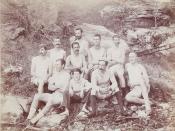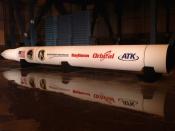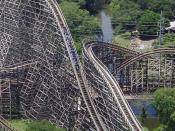Basic Physics of Rowing
1. Propulsion
2. Resistance
3. Kinetic Energy
4. Centre of Mass
5. Speed Variation
6. Balance
7. Levers
8. Gearing
9. Appendix: Newton's Laws of Motion
1. Propulsion
A boat accelerates through the action/reaction principle (Newton's 3rd Law). You move water one way with your oar, the boat moves the other way. The momentum (=mass x velocity) you put into the water will be equal and opposite to the momentum acquired by the boat.
Consider a boat before and after a stroke.
Figure (1.1)
Before the stroke, total momentum p = 0, since everything is at rest.
After the stroke, total momentum: p = mbvb - mwvw = 0 because the total momentum can't change (Newton's 2nd Law).
E.g. for a boat+crew mass mb = 100 kg (i.e. a single sculler) to accelerate from rest to vb = 1 m/s, requires either mw= 10 kg water to be accelerated to vw = 10 m/s, or mw = 20 kg water to vw = 5 m/s, or any other combination of mw and vw that gives the product mwvw = mbvb = 100 kg m/s.
During the normal stroke (i.e. with the boat already moving) it is less obvious that water is moved backwards in order to keep the boat moving forwards since the blades appear to `lock' in where they are placed, but if you look at the puddles when the blades are extracted it's clear that water is moved. There has to be some slippage in order to accelerate the boat, although, from energy considerations (section 3), this should be made as small as possible.
So what about if you push off the bottom of the river, or a series of poles planted along the river bank, rather than the water? (I hear you ask). Well,


